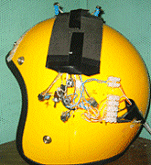The God Helmet has been mistakenly criticized on the grounds that it's fields (from 10 to 50 milligauss) are too weak to influence the brain. This error originates with a Swedish Researcher (Pehr Granqvist) who used an incorrect setup for his God Helmet, and then offered several contrived explanations for why his attempt at replicating it's effects failed. These included the mistaken claim that the fields were too weak to affect the brain. In fact, magnetic fields do pass into and through the brain. They aren't affected by the scalp or skull, because there is no such thing as a magnetic insulator. Nothing can block a magnetic field, including the human head. It's a law of physics.
The God Helmet Debate. Yes, Weak Magnetic Fields Can Influence Brain Activity - The Evidence.
Todd Murphy
One Author, misinformed by a research paper by P. Granqvist, claimed that "the magnetic fields generated by the God helmet are far too weak to penetrate the cranium and influence neurons within. Transcranial magnetic stimulation (TMS) uses field strengths of around 1.5 Tesla in order to induce currents strong enough to depolarize neurons through the skull and cause them to fire." In fact, TMS often uses fields of 1 Tesla (a very strong field), and enough electricity (two to three thousand volts @ 2 to 3 kilowatts) to power 3 small electric heaters, or sixteen televisions (25").
As it happens, there are many scientific papers showing that low-intensity magnetic fields (using less than 10 volts of electricity, and around as strong as those produced between stereo headphones and blow dryers) have measurable effects on the brain. Some of them are many orders of magnitude below the fields used in TMS.
The following list of studies shows that weak magnetic fields can and do influence the brain. The list begins with TMS (for comparison), and the field strengths are ordered from strongest to weakest. There are several units of measurement for magnetic fields, including: Tesla, Microtesla, Picotesla, Gauss and Milligauss, to name only a few. This makes it difficult for non-specialists to compare one field to another. To make the field strengths clear, all values are converted to the same unit (The Milligauss or mG) and compared to the field strength used in TMS (with a percent). Links to the research papers are also given.
We can see Dr. M.A. Persinger's finding that low-intensity magnetic fields affect the brain has been corroborated by several other researchers, and it's hoped that this page will help prevent future misunderstandings of this point.
The conclusion is straightforward; claims that low-intensity magnetic fields can't influence the brain aren't valid. The evidence appears below. Current induction is not the only way magnetic fields can affect the brain. Resonance between the fields used in the stimulation and the fields within the brain (appearing around it's electrical activity) explains some, but not necessarily all, of the results appearing below. In fact, the mechanism for the effects of low-intensity magnetic fields on the brain has been known for decades.
